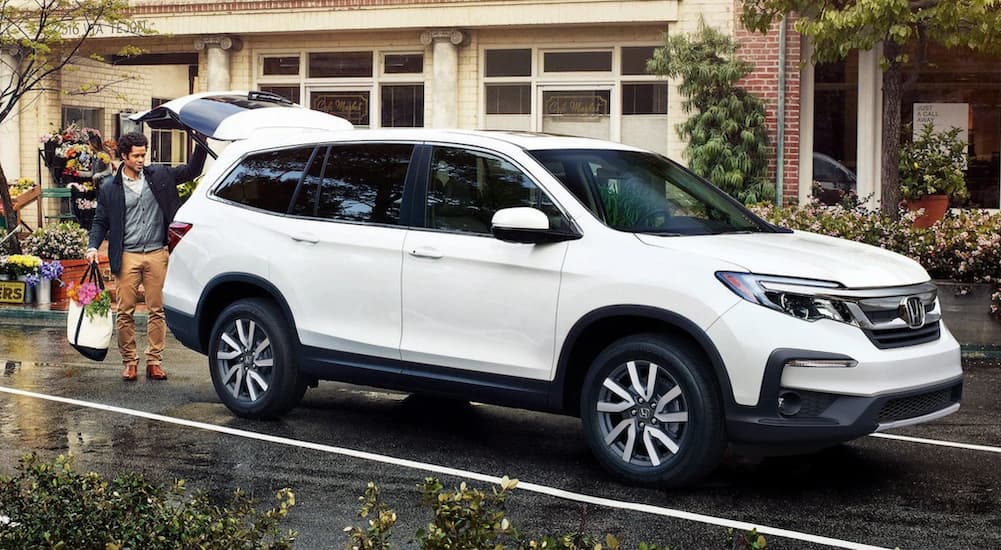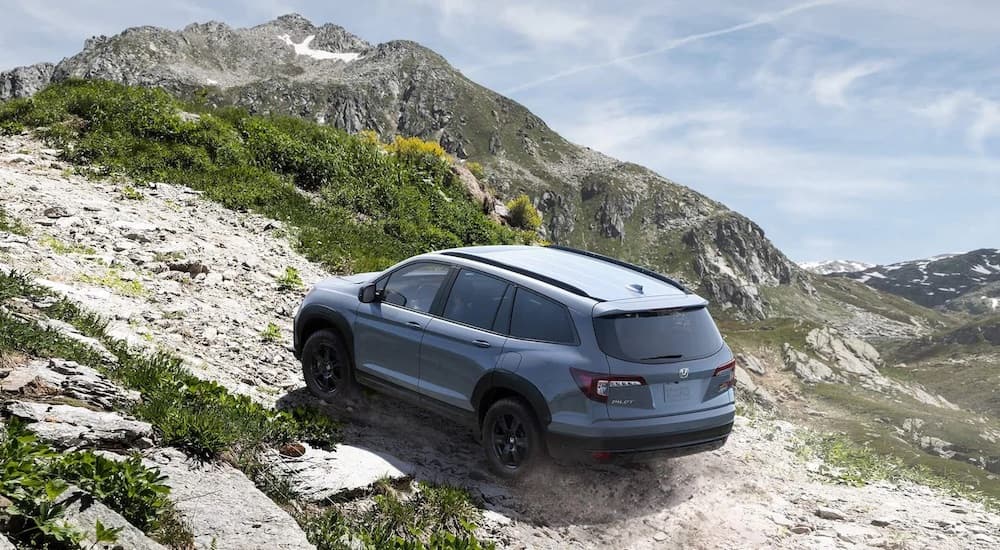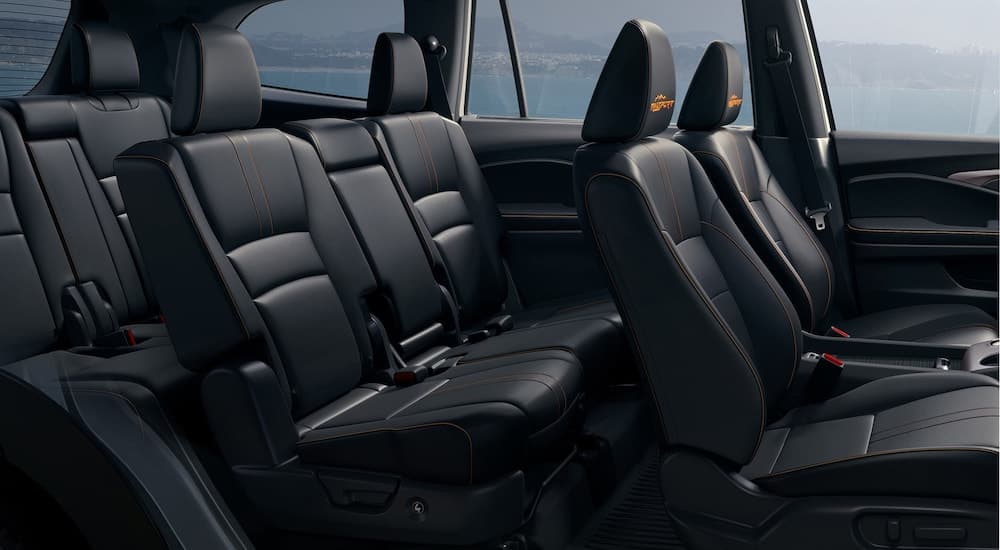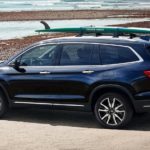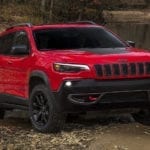The Honda Pilot occupies a slot in a segment hard-fought among its peers. The crossover SUV segment has many great options to keep it competitive, but when it comes to three-row vehicles, where does the Honda Pilot sit, and how does it stack up against the competition? Well, the family-oriented utility vehicle has managed to stay in the top ten sales within the segment often enough, thanks to a large section of the market still in need of a good family vehicle. But what actually eats into the sales of the Honda Pilot, and how well does it stave off its nearest competitors?
Well, the Honda Pilot is in the precarious position of being bigger than the standard midsize SUV, but not quite big enough to be considered a large SUV. It also has a starting price that is beyond the upper limits of the typical compact SUV and some of the luxury-priced midsize SUVs, so it means that people who go looking for a Honda Pilot for sale are doing so from the position of having a lot of different options to choose from—and yet, time and time again, they go with the Pilot. In some ways, that’s good news for Honda, but there’s more to the story than just the Pilot hanging on to a tough spot where midsize, crossovers, three-rows, and full-size SUVs are all vying for a chance to occupy its sales slot.
Outselling Midsize Luxury SUVs…
The Honda Pilot isn’t necessarily competing with midsize luxury SUVs, but it edges close to that category when you look at pricing and sales data. In fact, there’s barely a $9,000 difference between the starting MSRP of a 2023 Lexus RX and a 2023 Honda Pilot. That might seem like a world of difference between values, but consider that that pricing gulf shrinks significantly when you compare the Trailsport or Elite to the midsize luxury division, where the costs are nearly the same with some of the luxury brand trims in the midsize segment.
However, to Honda’s credit, the diversity of trim variation and pricing helps keep the Honda Pilot slightly edging out the midsize luxury SUV division’s top-selling vehicle (the Lexus RX) by almost 5,000 units when looking at the sales data from the previous year. That’s not the biggest lead, but it does showcase that in its segment—where it’s competing with a lot of similarly priced vehicles in adjacent segments—it’s still able to hold its own against the competition in a very similarly priced segment.
…But Can’t Quite Top the Crossover Chart
The biggest hurdle the Honda Pilot faces, however, is other vehicles in the crossover segment that undercut it in price. Overall, the Pilot has managed to place ninth in the 2022 US sales charts for midsize SUVs, which is quite the feat given the stiff competition. What kind of competition? Well, we’re talking about a division headlined by the Jeep Grand Cherokee and followed closely by the Toyota Highlander, Ford Explorer, and Jeep Wrangler.
The Pilot is also competing in a division that hosts the Toyota 4runner, Subaru Outback, and even the Ford Bronco. It might be a bit of a head-scratcher for some, given the diversity of names being thrown around, but keep in mind that the midsize division also includes some three-row SUVs, some two-door off-road SUVs, and some crossover SUVs. So you get this massive mish-mash of different vehicles all competing for the top spot. However, despite outselling the best-selling luxury-midsize SUV in an adjacent category, the Pilot struggles against such a vast array of other SUVs—especially some of the more rugged and compact off-road vehicles—where you wouldn’t expect the Pilot to fare very well at all.
But the fact that the Pilot has still managed to hold its own even against vehicles outside the crossover and family SUV categories speaks well to its standing in the market. Even with all this competition, people still flock to the Honda Pilot. That obviously speaks well to Honda’s marketing department, having kept the Pilot visible in such a crowded category. But then, beyond the outliers and crossovers, which brands and models are the Pilot directly competing with, and how well does it fare against them?
Kia, Mazda, Chevy, Beware
While it’s easy to make excuses for the sales one way or another against vehicles just outside or adjacent to the Pilot’s segment, what about its direct competitors in the three-row crossover SUV segment? Well, those would be the Volkswagen Atlas, the Subaru Ascent, the Kia Telluride, Mazda CX-9, and the Chevy Traverse. These are all midsize-class SUVs with a third row, making them crossover SUVs; too big to be proper midsize vehicles but not quite big enough to be considered full-size or large SUVs.
The interesting thing about it is that, in its segment, the Honda Pilot is one of the best-selling vehicles of the three-row crossover family SUV division. The only ones to have managed to outpace the Pilot are the Toyota 4Runner, Ford Explorer, Toyota Highlander, and Jeep Grand Cherokee L. (Certainly not bad company to keep.) The other thing to keep in mind is that, in the case of the 4Runner and Grand Cherokee, they lean more into the off-road enthusiast segments than chiefly being family-oriented SUVs, but that hasn’t slowed down their sales or popularity over the years.
As for the others, they all trail behind the Pilot for one reason or another. But what makes the Pilot stand out from the competition, and why has it managed to keep ahead of other family-themed three-row SUVs in the crossover segment? Well, this all boils down to a number of factors and why so many people are lured into looking for a Honda Pilot over the other three-row family SUVs.
What Makes the Pilot More Popular Than Its Competitors?
Outselling the Kia Telluride, Mazda CX-9, and Chevy Traverse means Honda is doing something right. Is it price? Not quite. If you compare the Pilot to the Chevy Traverse, GMC Acadia, Hyundai Palisade, Kia Telluride, and CX-9, it has a starting MSRP that’s actually higher than the aforementioned competitors it outsells. However, where it may have a higher price of entry than some of its three-row peers, it more than makes up for it with its features, stability, reliability, and long-term cost-saving functionality.
For instance, compared to the Chevy Traverse, you get 10% more total cargo volume with the Pilot and a better overall fuel economy regardless of the drivetrain configuration. The same also applies to other three-row SUVs, such as the Dodge Durango, Kia Telluride, and—once again—the Mazda CX-9. (Are you seeing a pattern here?)
Essentially, where it counts, the Honda Pilot offers a lot of the basics that SUV shoppers want—especially those looking for a good family vehicle. Thus, what it may lack in the style and luxury department, it makes up for it with basic safety amenities provided by the Honda Sensing suite, a reliable V6 that requires only essential maintenance to keep running, and all of the fundamental interior features to keep occupants safe, comfortable, and engaged. The Pilot has maintained a high-reliability rating among its customers, over the years, and this has helped give it a strong and lasting appeal among SUV shoppers. And that brings us to the final important factor: they last a long time.
More Reliable Than Its Counterparts
One thing you may not hear enough about—as to why some vehicles sell so well—is that long-term reliability is a huge selling point for people who want to make an investment as opposed to a purchase. Someone buying a three-row SUV with the intent to use it as a family vehicle—to endure young toddlers, growing teens, and graduating college students—means having a vehicle that can go well beyond the 100,000-mile mark. This is one area where you see the Pilot excel and why so many people are gung-ho for the Honda Pilot.
As many reports about the Honda Pilot’s reliability indicate, it’s not uncommon for them to exceed the 200,000-mile mark, and some Pilot owners report that they have managed to get more than 370,000 miles out of their Pilot. That’s one of the biggest selling points for any vehicle: long-lasting word of mouth. No amount of corporate marketing can compensate for a grassroots groundswell of positive reviews from happy customers. The Pilot has organically garnered this support structure over the years and has helped maintain its sales ever since. In many ways, the Honda Pilot has managed to outdo its nearest peers, all due to being well-built.
The V6 that Honda tucked into the Pilot with each successive generation has also proven to be more than reliable, and the Pilot has also garnered multiple five-star ratings over the years from the NHTSA. This makes it both dependable and safe, and when the average SUV shopper looking for a good three-row family vehicle is shopping around, it’s not hard to see why they would aim straight for the Pilot with its safety ratings, strong public backing as a long-running vehicle, and its roomy interior for all three rows. It’s easy to see how the Pilot has maintained its position on the sales charts and why it continues to be one of the front-runners among three-row family crossovers.
